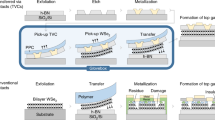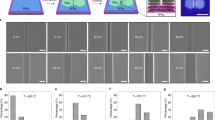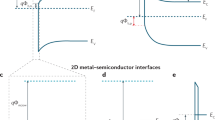Abstract
Two-dimensional semiconductors such as transition metal dichalcogenides are of potential use in electronic and optoelectronic devices due to their high mobility, direct optical bandgap and mechanical flexibility. These semiconductors are often encapsulated with hexagonal boron nitride to minimize extrinsic disorder and improve performance, but it is challenging to make high-quality contacts to encapsulated high-purity monolayers. Here we show that metal contacts embedded within hexagonal boron nitride can be transferred onto clean transition metal dichalcogenide monolayers, in an approach that reduces doping, strain and interfacial roughness compared with evaporated metal contacts. Contacts to encapsulated ultraclean tungsten diselenide monolayers created using this technique exhibit a room-temperature contact resistance of around 5 kΩ μm, and provide transistors with zero hysteresis and room-temperature mobility of 655 cm2 V−1 s−1. The contacts also exhibit a transfer length of 1 μm, which is several orders of magnitude larger than the channel thickness.
This is a preview of subscription content, access via your institution
Access options
Access Nature and 54 other Nature Portfolio journals
Get Nature+, our best-value online-access subscription
$29.99 / 30 days
cancel any time
Subscribe to this journal
Receive 12 digital issues and online access to articles
$119.00 per year
only $9.92 per issue
Buy this article
- Purchase on Springer Link
- Instant access to full article PDF
Prices may be subject to local taxes which are calculated during checkout





Similar content being viewed by others
Data availability
The data that support the plots within this paper and other findings of this study are available from the corresponding authors upon reasonable request.
Change history
14 September 2022
In the version of this article initially published, there was a conversion error in Fig. 1b which has now been restored in the HTML and PDF versions of the article.
References
Radisavljevic, B., Radenovic, A., Brivio, J., Giacometti, V. & Kis, A. Single-layer MoS2 transistors. Nat. Nanotechnol. 6, 147–150 (2011).
Wang, Q. H., Kalantar-Zadeh, K., Kis, A., Coleman, J. N. & Strano, M. S. Electronics and optoelectronics of two-dimensional transition metal dichalcogenides. Nat. Nanotechnol. 7, 699–712 (2012).
Manzeli, S., Ovchinnikov, D., Pasquier, D., Yazyev, O. V. & Kis, A. 2D transition metal dichalcogenides. Nat. Rev. Mater. 2, 17033 (2017).
Chhowalla, Manish, Jena, Debdeep & Zhang, H. Two-dimensional semiconductors for transistors. Nat. Rev. Mater. 1, 16052 (2016).
Liu, Y. et al. Promises and prospects of two-dimensional transistors. Nature 591, 43–53 (2021).
Rhodes, D., Chae, S. H., Ribeiro-Palau, R. & Hone, J. Disorder in van der Waals heterostructures of 2D materials. Nat. Mater. 18, 541–549 (2019).
Geim, A. K. & Grigorieva, I. V. Van der Waals heterostructures. Nature 499, 419–425 (2013).
Jariwala, D., Marks, T. J. & Hersam, M. C. Mixed-dimensional van der Waals heterostructures. Nat. Mater. 16, 170–181 (2017).
Novoselov, K., Mishchenko, A., Carvalho, A. & Neto, A. C. 2D materials and van der Waals heterostructures. Science 353, aac9439 (2016).
Edelberg, D. et al. Approaching the intrinsic limit in transition metal diselenides via point defect control. Nano Lett. 19, 4371–4379 (2019).
Shi, Q. et al. Odd- and even-denominator fractional quantum Hall states in monolayer WSe2. Nat. Nanotechnol. 15, 569–573 (2020).
Cui, X. et al. Multi-terminal transport measurements of MoS2 using a van der Waals heterostructure device platform. Nat. Nanotechnol. 10, 534–540 (2015).
Dean, C. R. et al. Boron nitride substrates for high-quality graphene electronics. Nat. Nanotechnol. 5, 722–726 (2010).
Cui, X. et al. Low-temperature ohmic contact to monolayer MoS2 by van der Waals bonded Co/h-BN electrodes. Nano Lett. 17, 4781–4786 (2017).
Liu, Y. et al. Toward barrier free contact to molybdenum disulfide using graphene electrodes. Nano Lett. 15, 3030–3034 (2015).
Liu, Y. et al. Approaching the Schottky–Mott limit in van der Waals metal–semiconductor junctions. Nature 557, 696–700 (2018).
Jung, Y. et al. Transferred via contacts as a platform for ideal two-dimensional transistors. Nat. Electron. 2, 187–194 (2019).
Wang, Y. et al. Van der Waals contacts between three-dimensional metals and two-dimensional semiconductors. Nature 568, 70–74 (2019).
Shen, P.-C. et al. Ultralow contact resistance between semimetal and monolayer semiconductors. Nature 593, 211–217 (2021).
Telford, E. J. et al. Via method for lithography free contact and preservation of 2D materials. Nano Lett. 18, 1416–1420 (2018).
Wang, L. et al. One-dimensional electrical contact to a two-dimensional material. Science 342, 614–617 (2013).
Gere, J. M. & Goodno, B. J. Mechanics of Materials 8th edn (Stanford: Cengage Learning, 2013).
Lee, C. et al. Frictional characteristics of atomically thin sheets. Science 328, 76–80 (2010).
Iqbal, M. W., Shahzad, K., Akbar, R. & Hussain, G. A review on Raman finger prints of doping and strain effect in TMDCs. Microelectron. Eng. 219, 111152 (2020).
Schroder, D. K. Semiconductor Material and Device Characterization (John Wiley & Sons, 2006).
Fang, H. et al. High-performance single layered WSe2 p-FETs with chemically doped contacts. Nano Lett. 12, 3788–3792 (2012).
Allain, A. & Kis, A. Electron and hole mobilities in single-layer WSe2. ACS Nano 8, 7180–7185 (2014).
Chen, C.-H. et al. Hole mobility enhancement and p-doping in monolayer WSe2 by gold decoration. 2D Mater. 1, 034001 (2014).
Wu, Z. et al. Defects as a factor limiting carrier mobility in WSe2: a spectroscopic investigation. Nano Res. 9, 3622–3631 (2016).
Reeves, G. & Harrison, H. Obtaining the specific contact resistance from transmission line model measurements. IEEE Electron Device Lett. 3, 111–113 (1982).
Wang, Y. et al. Does p-type ohmic contact exist in WSe2–metal interfaces? Nanoscale 8, 1179–1191 (2016).
Ni, C.-N. et al. Ultra-low contact resistivity with highly doped Si:P contact for nMOSFET. In 2015 Symposium on VLSI Technology (VLSI Technology) T118–T119 (IEEE, 2015).
Lu, W., Guo, A., Vardi, A. & del Alamo, J. A. A test structure to characterize nano-scale ohmic contacts in III-V MOSFETs. IEEE Electron Device Lett. 35, 178–180 (2014).
Guo, Y. et al. Study on the resistance distribution at the contact between molybdenum disulfide and metals. ACS Nano 8, 7771–7779 (2014).
Moon, I. et al. Analytical measurements of contact resistivity in two-dimensional WSe2 field-effect transistors. 2D Mater. 8, 045019 (2021).
Peng, L.-M., Zhang, Z. & Qiu, C. Carbon nanotube digital electronics. Nat. Electron. 2, 499–505 (2019).
Liu, Y., Zhang, J. & Peng, L.-M. Three-dimensional integration of plasmonics and nanoelectronics. Nat. Electron. 1, 644–651 (2018).
Zhou, J. et al. A library of atomically thin metal chalcogenides. Nature 556, 355–359 (2018).
Acknowledgements
This work was primarily supported by the NSF MRSEC program at Columbia through the Center for Precision-Assembled Quantum Materials (DMR-2011738), in collaboration with the National Research Foundation of Korea through the Global Research Laboratory Program (2016K1A1A2912707). Control experiments (Z.W.) were supported by the Department of Energy (DE-SC0016703). Synthesis of boron nitride (K.W. and T.T.) was supported by the Elemental Strategy Initiative conducted by the MEXT, Japan (grant no. JPMXP0112101001), and JSPS KAKENHI (grant nos. JP19H05790 and JP20H00354).
Author information
Authors and Affiliations
Contributions
Y.L. conceived, led and was involved in all aspects of the project and performed all the design, fabrication, measurement, simulation and data analysis. S.L. grew the WSe2 crystals and performed the scanning tunnelling microscopy characterizations of the bulk WSe2 crystals. Z.W. performed the control experiments with evaporated contacts. K.W. and T.T. grew the hBN crystals. W.J.Y. and J.H. advised on the project. Y.L. and J.H. discussed the results and co-wrote the manuscript with input from all the authors.
Corresponding authors
Ethics declarations
Competing interests
The authors declare no competing interests.
Peer review
Peer review information
Nature Electronics thanks Takamasa Kawanago, Seongjun Park and the other, anonymous, reviewer(s) for their contribution to the peer review of this work.
Additional information
Publisher’s note Springer Nature remains neutral with regard to jurisdictional claims in published maps and institutional affiliations.
Supplementary information
Supplementary Information
Supplementary Figs. 1–15 and Sections 1–15.
Rights and permissions
Springer Nature or its licensor holds exclusive rights to this article under a publishing agreement with the author(s) or other rightsholder(s); author self-archiving of the accepted manuscript version of this article is solely governed by the terms of such publishing agreement and applicable law.
About this article
Cite this article
Liu, Y., Liu, S., Wang, Z. et al. Low-resistance metal contacts to encapsulated semiconductor monolayers with long transfer length. Nat Electron 5, 579–585 (2022). https://doi.org/10.1038/s41928-022-00808-9
Received:
Accepted:
Published:
Issue Date:
DOI: https://doi.org/10.1038/s41928-022-00808-9
This article is cited by
-
Visualizing moiré ferroelectricity via plasmons and nano-photocurrent in graphene/twisted-WSe2 structures
Nature Communications (2023)



